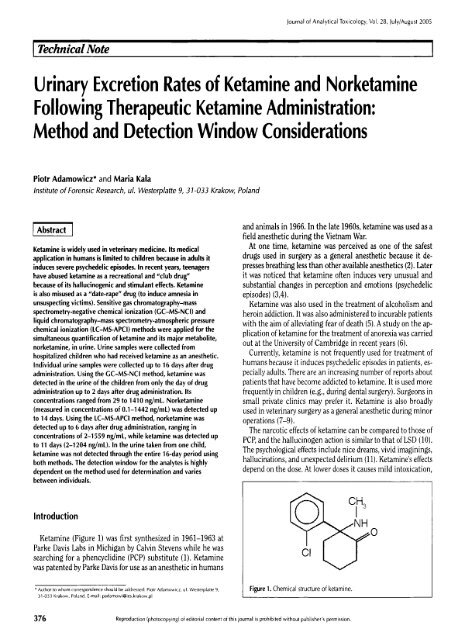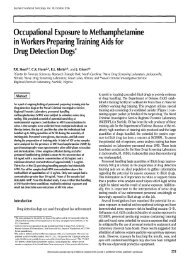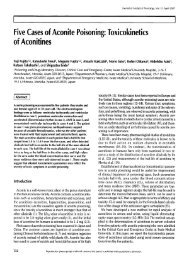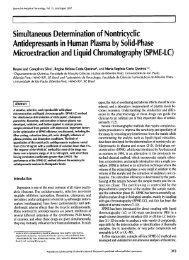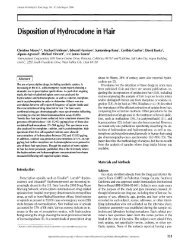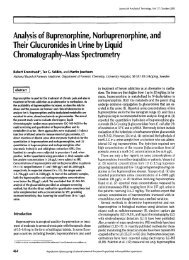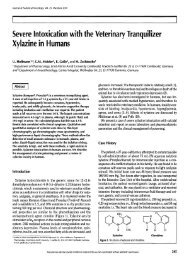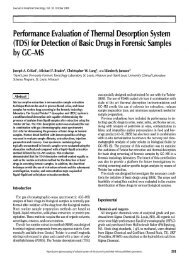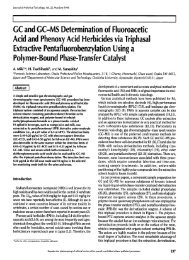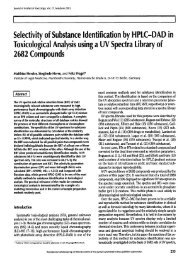Urinary Excretion Rates of Ketamine and Norketamine Following ...
Urinary Excretion Rates of Ketamine and Norketamine Following ...
Urinary Excretion Rates of Ketamine and Norketamine Following ...
Create successful ePaper yourself
Turn your PDF publications into a flip-book with our unique Google optimized e-Paper software.
[ TechnicalNote<br />
Journal <strong>of</strong> Analytical Toxicology, Vol. 28, July/August 2005<br />
<strong>Urinary</strong> <strong>Excretion</strong> <strong>Rates</strong> <strong>of</strong> <strong>Ketamine</strong> <strong>and</strong> <strong>Norketamine</strong><br />
<strong>Following</strong> Therapeutic <strong>Ketamine</strong> Administration:<br />
Method <strong>and</strong> Detection Window Considerations<br />
Piotr Adamowicz* <strong>and</strong> Maria Kala<br />
Institute <strong>of</strong> Forensic Research, ul. Westerplatte 9, 31-033 Krakow, Pol<strong>and</strong><br />
Abstract I<br />
<strong>Ketamine</strong> is widely used in veterinary medicine. Its medical<br />
application in humans is limited to children because in adults it<br />
induces severe psychedelic episodes9 In recent years, teenagers<br />
have abused ketamine as a recreational <strong>and</strong> "club drug"<br />
because <strong>of</strong> its hallucinogenic <strong>and</strong> stimulant effects. <strong>Ketamine</strong><br />
is also misused as a "date-rape" drug (to induce amnesia in<br />
unsuspecting victims). Sensitive gas chromatography-mass<br />
spectrometry-negative chemical ionization (GC-MS-NCI) <strong>and</strong><br />
liquid chromatography-mass spectrometry-atmospheric pressure<br />
chemical ionization (LC-MS-APCI) methods were applied for the<br />
simultaneous quantification <strong>of</strong> ketamine <strong>and</strong> its major metabolite,<br />
norketamine, in urine. Urine samples were collected from<br />
hospitalized children who had received ketamine as an anesthetic.<br />
Individual urine samples were collected up to 16 days after drug<br />
administration. Using the GC-MS-NCI method, ketamine was<br />
detected in the urine <strong>of</strong> the children from only the day <strong>of</strong> drug<br />
administration up to 2 days after drug administration, its<br />
concentrations ranged from 29 to 1410 ng/mL. <strong>Norketamine</strong><br />
(measured in concentrations <strong>of</strong> 0.1-1442 ng/mL) was detected up<br />
to 14 days. Using the LC-MS-APCI method, norketamine was<br />
detected up to 6 days after drug administration, ranging in<br />
concentrations <strong>of</strong> 2-1559 ng/mL, while ketamine was detected up<br />
to 11 days (2-1204 ng/mL). In the urine taken from one child,<br />
ketamine was not detected through the entire 16-day period using<br />
both methods. The detection window for the analytes is highly<br />
dependent on the method used for determination <strong>and</strong> varies<br />
between individuals.<br />
Introduction<br />
<strong>Ketamine</strong> (Figure 1) was first synthesized in 196]-1963 at<br />
Parke Davis Labs in Michigan by Calvin Stevens while he was<br />
searching for a phencyclidine (PCP) substitute (1). <strong>Ketamine</strong><br />
was patented by Parke Davis for use as an anesthetic in humans<br />
9 Author to whom correspondence should be addressed: Piotr Adamowicz, ul. Westerplatte 9,<br />
31-033 Krakow, Pol<strong>and</strong>. E-mail: padamowi@ies.krakow.pl<br />
<strong>and</strong> animals in 1966. In the late 1960s, ketamine was used as a<br />
field anesthetic during the Vietnam War.<br />
At one time, ketamine was perceived as one <strong>of</strong> the safest<br />
drugs used in surgery as a general anesthetic because it de-<br />
presses breathing less than other available anesthetics (2). Later<br />
it was noticed that ketamine <strong>of</strong>ten induces very unusual <strong>and</strong><br />
substantial changes in perception <strong>and</strong> emotions (psychedelic<br />
episodes) (3,4).<br />
<strong>Ketamine</strong> was also used in the treatment <strong>of</strong> alcoholism <strong>and</strong><br />
heroin addiction. It was also administered to incurable patients<br />
with the aim <strong>of</strong> alleviating fear <strong>of</strong> death (5). A study on the ap-<br />
plication <strong>of</strong> ketamine for the treatment <strong>of</strong> anorexia was carried<br />
out at the University <strong>of</strong> Cambridge in recent years (6).<br />
Currently, ketamine is not frequently used for treatment <strong>of</strong><br />
humans because it induces psychedelic episodes in patients, es-<br />
pecially adults. There are an increasing number <strong>of</strong> reports about<br />
patients that have become addicted to ketamine. It is used more<br />
frequently in children (e.g., during dental surgery). Surgeons in<br />
small private clinics may prefer it. <strong>Ketamine</strong> is also broadly<br />
used in veterinary surgery as a general anesthetic during minor<br />
operations (7-9).<br />
The narcotic effects <strong>of</strong> ketamine can be compared to those <strong>of</strong><br />
PCP, <strong>and</strong> the hallucinogen action is similar to that <strong>of</strong> LSD (10).<br />
The psychological effects include nice dreams, vivid imaginings,<br />
hallucinations, <strong>and</strong> unexpected delirium (11). <strong>Ketamine</strong>'s effects<br />
depend on the dose. At lower doses it causes mild intoxication,<br />
CI<br />
Figure 1. Chemical structure <strong>of</strong> ketamine.<br />
376 Reproduction (photocopying) <strong>of</strong> editorial content <strong>of</strong> this journal is prohibited without publisher's permission.<br />
ClH3
Journal <strong>of</strong> Analytical Toxicology, Vol. 28, July/August 2005<br />
dreamy thinking, disturbances <strong>of</strong> speech, hearing <strong>and</strong> seeing,<br />
lack <strong>of</strong> muscle coordination, disorientation, anxiety, disinhibi-<br />
tions, euphoria, seeing the world differently, <strong>and</strong> irrational be-<br />
havior. Higher doses cause great difficulty in moving, respiratory<br />
disturbances, seizures, <strong>and</strong> nausea. Extreme doses produce com-<br />
plete disassociation from reality <strong>and</strong> loss <strong>of</strong> consciousness, hal-<br />
lucinations, out-<strong>of</strong>-body experiences, <strong>and</strong> so-called "near-death<br />
experiences". Frequent intake <strong>of</strong> ketamine can lead to psycho-<br />
logical <strong>and</strong> physical dependency <strong>and</strong> tolerance (12-14).<br />
Deaths by overdose in the absence <strong>of</strong> other drugs are excep-<br />
tionally rare (5,15). Overdose in the case <strong>of</strong> ketamine is a very<br />
relative term, because doses used by drug-addicts are typically<br />
lower than necessary for anesthesia. The highest therapeutic<br />
dose is 13 mg/kg, while doses taken to induce psychedelic effects<br />
rarely exceed 2 mg/kg. Accidental deaths such as falling from a<br />
great height, death by hypothermia, car accident, or drowning<br />
in a bathtub are the most common ketamine-related deaths<br />
(7).<br />
<strong>Ketamine</strong> is rapidly metabolized to an active metabolite, nor-<br />
ketamine, <strong>and</strong> an inactive metabolite, 6-hydroxynorketamine.<br />
The major pathway is N-demethylation to norketamine by the<br />
microsomal cytochrome P450 system (8). <strong>Norketamine</strong> is also<br />
hydroxylated to 6-hydroxynorketamine, conjugated, <strong>and</strong> ex-<br />
creted in the urine. Hydroxylation <strong>and</strong> conjugation <strong>of</strong> glu-<br />
curonic acid with norketamine <strong>and</strong> its hydroxylated metabolites<br />
generate water-soluble compounds to facilitate urinary excretion<br />
(9). <strong>Norketamine</strong> also undergoes dehydrogenation to dehy-<br />
dronorketamine. It had been suggested that dehydronorke-<br />
Table I <strong>Urinary</strong> <strong>Excretion</strong> <strong>of</strong> <strong>Ketamine</strong> <strong>and</strong> <strong>Norketamine</strong> <strong>Following</strong> <strong>Ketamine</strong> Administration to Children*<br />
Concentrations (ng/mL) Measured by Concentrations (ng/mL) Measured by<br />
LC-MS-APCI GC-MS-NCI LC-MS-APCI GC-MS-NCI<br />
Day <strong>Ketamine</strong> <strong>Norketamine</strong> <strong>Ketamine</strong> <strong>Norketamine</strong> Day <strong>Ketamine</strong> <strong>Norketamine</strong> <strong>Ketamine</strong> <strong>Norketamine</strong><br />
Case 1<br />
0-1 urine samples not collected<br />
2 - 50 - 57<br />
3 - 7 - 3<br />
4 - 5 - 2<br />
5 - 5 - 0.4<br />
6 - 4 - 0.4<br />
7 - - 0.2<br />
8 - - 0.06<br />
9 - - 0.1<br />
10 - - 0.2<br />
11 - - 0.2<br />
12 - - - 0.1<br />
13 - - 0.08<br />
14 - - - 0.05<br />
15-16 urine samples tested negative<br />
Case 2A<br />
0 urine sample not collected<br />
1 41 264 41 227<br />
2 4 18 - 11<br />
3 - 3 - 2<br />
4 - - - 0.4<br />
5 - - - 0.6<br />
Case 2B<br />
0 799 409 695 534<br />
1 52 387 58 325<br />
3 3 2 - 2<br />
5 - - - 0.1<br />
7 2 - - -<br />
9 6 - - -<br />
11 4 - - -<br />
Case 2C<br />
0 urine sample not collected<br />
1 813 548 1181 743<br />
2 195 417 296<br />
3 17 85 -<br />
4 7 17 -<br />
5 3 6 -<br />
Case 3<br />
0 urine sample not collected<br />
1 161 527<br />
2 110 34<br />
3 - 5<br />
4 - 3<br />
5 - 2<br />
6<br />
7<br />
Case 4<br />
0 502 1276<br />
1 12 206<br />
2 - 5<br />
3 - 2<br />
5 - 3<br />
6<br />
7-15 urine samples tested negative<br />
Case 5<br />
179<br />
156<br />
586<br />
496<br />
0 urine sample not collected<br />
1 30 166 29 147<br />
Case 6<br />
82<br />
13<br />
3<br />
430<br />
52<br />
2<br />
2<br />
1182<br />
0 1204 1559 1410 1442<br />
0.7<br />
0.1<br />
184<br />
1<br />
1 467 535 642 553<br />
2 55 52 71 72<br />
3 - 6 - 3<br />
4 - 4 - 1<br />
5 - 3 - 0.6<br />
6 - - 0.1<br />
* Day 0: the day <strong>of</strong> ketamine administration; Day 1 : the first day after ketamine administration; Cases 2A, 2B, <strong>and</strong> 2C represent urine samples collected from one patient to<br />
whom ketamine was administered three times during two-year period.<br />
0.06<br />
0.6<br />
0.1<br />
0.07<br />
377
tamine was an artifact <strong>of</strong> the analytical procedure [using a gas<br />
chromatography (GC) technique[ rather than a metabolite (16).<br />
Other authors (17) have detected ketamine, norketamine, <strong>and</strong><br />
dehydronorketamine in urine by liquid chromatography-mass<br />
spectrometry (LC-MS). <strong>Norketamine</strong> has one-third the activity<br />
<strong>of</strong> ketamine (18).<br />
Since the early 1990s, interest in this substance has grown<br />
among young people <strong>and</strong> an increasing number <strong>of</strong> reports have<br />
appeared about recreational use <strong>of</strong> this drug (19-22). <strong>Ketamine</strong><br />
is a "club drug" <strong>and</strong> its illicit use by teenagers at rave parties has<br />
also been reported. The major source <strong>of</strong> ketamine is diversion<br />
from veterinary clinics. It is also smuggled from countries<br />
where it is not legally controlled. Due to complex synthesis<br />
<strong>and</strong> difficulties with buying precursors, solvents, <strong>and</strong> reagents,<br />
ketamine is not manufactured in cl<strong>and</strong>estine laboratories. In<br />
pharmaceutical preparations, ketamine is sold in liquid form<br />
<strong>and</strong> the powder form is prepared by boiling <strong>of</strong>f the solution<br />
(18). It can be taken via intramuscular, intravenous, intranasal,<br />
oral, <strong>and</strong> rectal routes. <strong>Ketamine</strong> can also be smoked, some-<br />
times in combination with marijuana or tobacco (5,23). Oral<br />
doses are prepared from the powder by dissolving it in water,<br />
juice, or alcoholic beverages.<br />
Recently it has also been identified as a "date-rape" drug used<br />
for drugging unsuspecting victims <strong>and</strong> then raping them while<br />
the victim is still under its influence. In a typical scenario, the<br />
perpetrator surreptitiously adds ketamine to the alcoholic bev-<br />
erage <strong>of</strong> an unsuspecting person, who is subsequently sexually<br />
assaulted while under the influence <strong>of</strong> this substance. Many<br />
victims do not report the incident until several days after the<br />
event (24-26).<br />
These situations create a dem<strong>and</strong> for sensitive analytical<br />
methods to reveal the presence <strong>of</strong> the drug <strong>and</strong>/or metabolites<br />
in biological specimens collected from the subject. An impor-<br />
tant parameter in drug testing for forensic purposes is the de-<br />
tection window (i.e., how long after drug administration a<br />
person tests positive for the drug or metabolite).<br />
Obviously, detection times are highly dependent upon a<br />
number <strong>of</strong> factors including dosage, individual rates <strong>of</strong><br />
metabolism <strong>and</strong> excretion, method specificity, <strong>and</strong> detection<br />
limits. Consequently, detection times may vary between<br />
methods, <strong>and</strong> it is important to characterize the performance <strong>of</strong><br />
new methods with clinical drug specimens obtained under con-<br />
trolled conditions.<br />
Many analytical methods for the determination <strong>of</strong> ketamine<br />
<strong>and</strong> norketamine in biological materials are described in the lit-<br />
erature. Initially, conventional (27) <strong>and</strong> two-dimensional (28)<br />
thin-layer chromatography methods were applied, but these<br />
methods require high specimen volume <strong>and</strong> <strong>of</strong>ten lack the re-<br />
quired sensitivity. GC with nitrogen-phosphorus detection or<br />
electron capture detection methods, have been used for bio-<br />
transformation <strong>and</strong> disposition studies. However, validation pa-<br />
rameters were not defined or limits <strong>of</strong> detection (LOD) ranged<br />
from 10 to 100 ng/mL, which is insufficient. Many authors de-<br />
veloped HPLC with UV detection methods for separation, de-<br />
tection, <strong>and</strong> quantification <strong>of</strong> ketamine <strong>and</strong> norketamine, which<br />
can attain LODs <strong>of</strong> 5 ng/mL (29-32). Only GC-MS or LC-MS<br />
methods provide the sensitivity, selectivity, <strong>and</strong> specificity nec-<br />
378<br />
Journal <strong>of</strong> Analytical Toxicology, Vol. 28, July/August 2005<br />
essary for qualitative <strong>and</strong> quantitative data needed in forensic<br />
studies on a single ketamine exposure used as the date rape<br />
drug. These methods have been developed <strong>and</strong> described re-<br />
cently (17,33).<br />
This paper describes two analytical methods, GC-MS-negative<br />
chemical ionization (NCI) <strong>and</strong> LC-MS-atmospheric pressure<br />
chemical ionization (APCI), <strong>and</strong> their application to the analysis<br />
<strong>of</strong> urine samples collected from hospitalized children who re-<br />
ceived ketamine as an anesthetic. The GC-MS-NCI method was<br />
published previously by Negrusz et al. (34) <strong>and</strong> the authors <strong>of</strong><br />
this article developed the LC-MS-APCI method.<br />
Materials <strong>and</strong> Methods<br />
Chemicals<br />
<strong>Ketamine</strong>, norketamine, ketamine-d4, <strong>and</strong> norketamine-d4<br />
were purchased from Cerilliant Corporation (LGC Promochem,<br />
Warszawa, Pol<strong>and</strong>). The enzyme [3-glucuronidase (Type H-2<br />
crude solution, 110,350 units/mL from Helix pomatia) <strong>and</strong><br />
heptafluorobutyric anhydride (HFBA) were acquired from<br />
Sigma-Aldrich (Poznan, Pol<strong>and</strong>). The HCX Isolute | (10-mL,<br />
200-rag) extraction columns (product <strong>of</strong> International Sorbent<br />
Technology, Hengoed, U.K.) were supplied by Able & Jasco<br />
(Krakow, Pol<strong>and</strong>). All solvents <strong>and</strong> reagents were <strong>of</strong> analytical<br />
grade.<br />
Biological material<br />
Urine samples were collected from six hospitalized children<br />
(age 4-13 years, weight 17-68 kg) who had received a single in-<br />
travenous dose <strong>of</strong> ketamine as an anesthetic for short surgical<br />
procedures. One child received ketamine three times during a<br />
two-year period (case 2A, 2B, <strong>and</strong> 2C, Table I). The doses ranged<br />
from 0.75 to 1.59 mg/kg. Individual urine samples were col-<br />
lected every day or once every two days for 4-16 days. If the<br />
urine samples were not analyzed immediately, they were stored<br />
up to one month at-18~ prior to analysis.<br />
For validation <strong>of</strong> the LC-MS-APCI method, control urine<br />
samples were taken from healthy persons with no history <strong>of</strong> ke-<br />
tamine use.<br />
Solid-phase extraction (SPE)<br />
To the urine samples (2 mL for GC-MS-NCI procedure or<br />
1 mL for LC-MS-APCI procedure), an appropriate internal<br />
st<strong>and</strong>ard (IS, 1 ng <strong>of</strong> norketamine-d4 in 10 tJL <strong>of</strong> methanol for<br />
the GC-MS-NCI method <strong>and</strong> 100 ng each <strong>of</strong> norketamine-d4<br />
<strong>and</strong> ketamine-d4 in 10 IlL <strong>of</strong> methanol, for the LC-MS-APCI<br />
method) was added. This was followed by the addition <strong>of</strong> 1 mL<br />
<strong>of</strong> 0.1M acetate buffer (pH 5.5) <strong>and</strong> 50 IJL <strong>of</strong> ~-glucuronidase<br />
before the specimens were incubated for 90 min at 37~ After<br />
this, 1 mL <strong>of</strong> 1.93M acetic acid <strong>and</strong> deionized water (10 mL for<br />
GC-MS-NCI or 5 mL for LC-MS) were added to the samples<br />
<strong>and</strong> applied on the mixed-mode Isolute HCX SPE columns.<br />
Columns were preconditioned with methanol (3 mL), deion-<br />
ized water (3 mL), <strong>and</strong> 1.93M acetic acid (1 mL).<br />
The pretreated sample was slowly passed through the column
Journal <strong>of</strong> Analytical Toxicology, VoL 28, July/August 2005<br />
(approximately 5 rain) followed by rinsing with 3 mL <strong>of</strong> deion-<br />
ized water, 1 mL <strong>of</strong> 0.1M HC1, <strong>and</strong> 3 mL <strong>of</strong> methanol. The<br />
column was dried under vacuum for 5 rain. The retained ana-<br />
lytes were eluted with a mixture <strong>of</strong> methylene chloride/iso-<br />
propanol/ammonium hydroxide (78:20:2, v/v) under gravity.<br />
The eluates were evaporated to dryness under a stream <strong>of</strong> air. In<br />
cases <strong>of</strong> analyte concentrations exceeding the upper level <strong>of</strong><br />
the respective calibration curve, the sample was diluted <strong>and</strong> the<br />
analysis was repeated.<br />
GC-MS-NCI analysis<br />
The dry residues were derivatized with 50 1JL <strong>of</strong> HFBA at<br />
60~ for 30 rain. After incubating, the excess derivatizing<br />
reagent was evaporated under air <strong>and</strong> the dry residue reconsti-<br />
tuted in 50 I~L <strong>of</strong> ethyl acetate before I IJL was injected into the<br />
GC-MS system.<br />
Quantitation <strong>of</strong> ketamine <strong>and</strong> norketamine was carried out<br />
using the Agilent Technologies 6890 series GC equipped with a<br />
5973 series mass selective detector (MSD) <strong>and</strong> a 6890 series au-<br />
tosampler (Agilent Technologies, Wilmington). The NCI mode<br />
was applied using methane as the reagent gas. The separation<br />
<strong>of</strong> analytes was performed with the use <strong>of</strong> a HP-5MS fused silica<br />
capillary column (30-m 0.25-mm i.d., 0.25-1Jm film thick-<br />
ness). The capillary inlet system was operated in the splitless<br />
mode. Instrumental conditions were as follows: injection port,<br />
280~ GC temperature program, 60~ for 1 min, ramp to<br />
310~ at 30~ <strong>and</strong> hold 3 min; transfer line, 280~ source,<br />
200~ quadrupole, 230~ The flow rate <strong>of</strong> carrier gas (helium)<br />
was I mL/min. The quantitative (underlined) <strong>and</strong> qualifier ions<br />
monitored for each derivatized compound were ketamine, m/z<br />
226, 357; norketamine, m/z 383 <strong>and</strong> 399; <strong>and</strong> norketamine-d4,<br />
m/z 387 <strong>and</strong> 403.<br />
LC-MS-APCI analysis<br />
The dry residue (after SPE <strong>and</strong> without derivatization) was re-<br />
constituted in 100 lJL <strong>of</strong> an acetonitrile (ACN)/water mix (1:4<br />
v/v). A 20-1~L sample was injected by autosampler into the<br />
LC-MS system.<br />
Analysis was performed with the HP-1100 series LC coupled<br />
to a MS equipped with an APCI interface (Hewlett Packard,<br />
Wilmington).<br />
The separation <strong>of</strong> analytes was performed with the use <strong>of</strong> a<br />
LiChroCART Purospher STAR RP-18e column (55- 4-mm<br />
i.d.) (Merck, Darmstadt, Germany) thermostated at 25~ The<br />
mobile phase consisted <strong>of</strong> 0.1% (v/v) formic acid in water <strong>and</strong><br />
ACN. The flow rate was 0.8 mL/min. All analyses were carried<br />
out in gradient mode: 0 min-10% ACN, 5 min-40% ACN, 6<br />
min-10% ACN, <strong>and</strong> 8 min-10% ACN.<br />
Nitrogen generated by a Whatman apparatus was used as a<br />
nebulizing gas. First, an autotuning procedure was carried out.<br />
Then optimization <strong>of</strong> MS parameters was accomplished by flow<br />
injection analysis to obtain the most intense ions for selected<br />
ion monitoring mode. <strong>Ketamine</strong> <strong>and</strong> norketamine at concen-<br />
trations <strong>of</strong> 100 ng/mL in mobile phase were individually injected<br />
directly into the MSD without chromatographic separation <strong>and</strong><br />
analyzed in full-scan mode (m/z range 50-500 ainu). For both<br />
analytes, the pseudomolecular ions <strong>of</strong> ketamine (m/z 238) <strong>and</strong><br />
<strong>of</strong> norketamine (m/z 224) were selected as the most repro-<br />
ducible <strong>and</strong> intense. Other parameters were as follows: frag-<br />
mentor voltage, 60 V; vaporizer temperature, 330~ capillary<br />
voltage, 4200 V; drying gas flow, 7 L/rain; temperature, 300~<br />
nebulizer pressure, 35 psi; corona current, 4.5 IIA. All data were<br />
acquired <strong>and</strong> analyzed by HP s<strong>of</strong>tware, ChemStation version<br />
A.06.03 for Windows NT.<br />
The calibration curves for ketamine <strong>and</strong> norketamine in urine<br />
consisted <strong>of</strong> 11 points for each compound, which covered the<br />
range <strong>of</strong> 0.5-2000 ng/mL. The calibrator solutions were pre-<br />
pared by adding known amounts each <strong>of</strong> the IS (ketamine-d4<br />
<strong>and</strong> norketamine-d4, 100 ng/mL each), ketamine, <strong>and</strong> norke-<br />
tamine to control urine (0, 0.5, 1, 2, 5, 10, 20, 100, 500, 1000,<br />
<strong>and</strong> 2000 ng/mL). The samples were hydrolyzed, extracted, <strong>and</strong><br />
analyzed by LC-MS-APCI in the same manner as described for<br />
the patients' urine samples. Peak-area ratios (ketamine/ke-<br />
tamine-d4; m/z 238/242 <strong>and</strong> norketamine/norketamine-d4; m/z<br />
224/228) were calculated for each st<strong>and</strong>ard <strong>and</strong> plotted against<br />
the known concentration <strong>of</strong> the st<strong>and</strong>ard.<br />
The method was validated by repetitive (at least three times)<br />
analysis <strong>of</strong> two different concentrations <strong>of</strong> spiked control urine<br />
samples containing 40 <strong>and</strong> 750 ng/mL <strong>of</strong> both target analytes<br />
(on the same day <strong>and</strong> over a period <strong>of</strong> three weeks).<br />
LOD, lower limit <strong>of</strong> quantification (LLOQ), <strong>and</strong> limit <strong>of</strong> lin-<br />
earity (LOL), as well as extraction recovery for ketamine <strong>and</strong><br />
norketamine (at concentrations <strong>of</strong> 40 <strong>and</strong> 750 ng/mL from<br />
spiked urine in comparison with unextracted drug solutions)<br />
were determined. Calculations were performed using Merck's<br />
Validation Manager Program.<br />
Results<br />
The GC-MS-NCI method (34) had an LOQ <strong>of</strong> 20 ng/mL for ke-<br />
tamine <strong>and</strong> 0.05 ng/mL for norketamine, <strong>and</strong> displayed a LOL<br />
across a concentration range <strong>of</strong> 20-1000 ng/mL <strong>and</strong> 0.050-1500<br />
ng/mL, respectively.<br />
The LC-MS-APCI method was characterized by the same val-<br />
idation parameters for both compounds: LOD <strong>of</strong> 0.5 ng/mL,<br />
LLOQ <strong>of</strong> 2 ng/mL, <strong>and</strong> LOL <strong>of</strong> 2-2000 ng/mL. Linear regression<br />
correlation coefficients <strong>of</strong> the calibration curves were 0.9997 for<br />
ketamine <strong>and</strong> 0.9999 for norketamine. Recovery <strong>of</strong> ketamine<br />
from urine was 107.86 3.66% at 40 ng/mL <strong>and</strong> 100.33<br />
1.87% at 750 ng/mL. Recovery for norketamine at the same low<br />
<strong>and</strong> high concentrations was 101.18 3.69% <strong>and</strong> 100.59<br />
1.75%, respectively. All values were high, but comparable <strong>and</strong><br />
reproducible. Coefficient <strong>of</strong> variations <strong>of</strong> the intra- <strong>and</strong> in-<br />
terassay precision did not exceed 4% for ketamine <strong>and</strong> norke-<br />
tamine at low concentration (40 ng/mL). These data for both an-<br />
alytes at the 750-ng/mL concentration were slightly lower. For<br />
ketamine the coefficient <strong>of</strong> variation was less than 2%.<br />
On the basis <strong>of</strong> the successful validation, both methods were<br />
applied to the determination <strong>of</strong> ketamine <strong>and</strong> norketamine in 62<br />
urine samples collected from six hospitalized children. <strong>Urinary</strong><br />
excretion pr<strong>of</strong>iles <strong>of</strong> ketamine <strong>and</strong> norketamine were presented<br />
in Figures 2-5 <strong>and</strong> Table I.<br />
After a single intramuscular ketamine dose, the drug was de-<br />
tected in the urine samples <strong>of</strong> five children. By the GC-MS-NCI<br />
379
method, ketamine was determined in the urine <strong>of</strong> two chil-<br />
dren up to i day after exposure in concentrations ranging from<br />
41 to 695 ng/mL; in the next two children up to 2 days after<br />
drug administration in concentrations ranging from 71 to 1410<br />
ng/mL, <strong>and</strong> in one child only on the day <strong>of</strong> drug administration,<br />
when its concentration was 586 ng/mL. <strong>Norketamine</strong> was de-<br />
tected in the urine <strong>of</strong> two children up to 6 days after dosing (in<br />
concentrations ranging from 0.07 ng/mL to 1442 ng/mL), in<br />
one child up to 5 days (in concentrations <strong>of</strong> 0.6-227 ng/mL), in<br />
another child up to 7 days (0.06-430 ng/mL), <strong>and</strong> in the last<br />
child up to 14 days (0.05-57 ng/mL).<br />
Using the LC-MS-APCI method, ketamine was detected (at<br />
concentrations <strong>of</strong> 4-1204 ng/mL) in three children up to two<br />
days after exposure <strong>and</strong> in two children up to one day (at con-<br />
centrations <strong>of</strong> 12-502 ng/mL) after exposure. <strong>Norketamine</strong> was<br />
detected up to three (at concentrations <strong>of</strong> 2-409 ng/mL), five<br />
(2-1559 ng/mL), <strong>and</strong> six days (4-50 ng/mL) after drug admin-<br />
istration.<br />
Using either method, neither ketamine nor norketamine were<br />
detected in the urine taken from one child through the entire<br />
16-day period.<br />
Data from Case 2 (Table I) demonstrated that repeated doses<br />
<strong>of</strong> ketamine (three times during a two-year period) resulted in<br />
its slower elimination. After the second dose (case 2B), the<br />
elimination <strong>of</strong> parent ketamine was extended to 11 days, <strong>and</strong><br />
after the third dose it was extended to 5 days after drug admin-<br />
2<br />
mc~e !<br />
iC~se 2A<br />
DC~se 2B<br />
, ~ Case 2C<br />
i Case 3<br />
! Case 4<br />
i<br />
I 9 Case 5<br />
[ [] Case 6<br />
Figure 2. The urinary excretion pr<strong>of</strong>iles <strong>of</strong> ketamine for six hospitalized<br />
children determined by GC-MS-NCI.<br />
2 i RCase 1<br />
: 9 Case 2A<br />
DCase 2B<br />
D Ca-se 2C<br />
it Case 3<br />
m Case 4<br />
[lCase 5 1<br />
[oca.se 6 [<br />
Figure 3. The urinary excretion pr<strong>of</strong>iles <strong>of</strong> norketamine for six hospital-<br />
ized children determined by GC-MS-NCI.<br />
380<br />
Journal <strong>of</strong> Analytical Toxicology, Vol. 28, July/August 2005<br />
istration. After each dose norketamine was excreted in the same<br />
5-day period.<br />
Overall elimination times <strong>of</strong> ketamine varied between the<br />
different children <strong>and</strong> the different methods.<br />
Discussion<br />
Because ketamine has become a popular club drug <strong>and</strong> date-<br />
rape drug, it is a subject <strong>of</strong> interest to forensic toxicologists, es-<br />
pecially regarding its detection times. Detection times indicate<br />
how long after drug administration a person excretes a drug or<br />
metabolite at a concentration above a specific method LOD.<br />
This makes sensitive methods with low LODs essential. The<br />
methods used in this study allowed for quantification <strong>of</strong> ke-<br />
tamine <strong>and</strong> norketamine at very low concentrations. The<br />
GC-MS-NCI method had an LOQ <strong>of</strong> 20 ng/mL for ketamine <strong>and</strong><br />
0.05 ng/mL for norketamine, <strong>and</strong> the LC-MS-APCI method<br />
provided an LOQ <strong>of</strong> 2 ng/mL for both compounds. The applied<br />
LC-MS-APCI method is more sensitive than elaborated by<br />
Moore et al. (17) who measured ketamine <strong>and</strong> norketamine<br />
with a LOD <strong>of</strong> 4 ng/mL for both analytes. A previously reported<br />
GC-MS method achieved an LOQ for ketamine <strong>of</strong> 13 ng/mL <strong>and</strong><br />
an LOQ for norketamine <strong>of</strong> 9 ng/mL (35).<br />
Both applied methods have advantages <strong>and</strong> disadvantages.<br />
~2<br />
=<br />
9 Case I<br />
iCase 2A<br />
[]Case 2B<br />
[Case 2C<br />
i 9 Case 3<br />
D Case 4<br />
9 Case 5<br />
[] Case 6<br />
Figure 4. The urinary excretion pr<strong>of</strong>iles <strong>of</strong> ketamine for six hospitalized<br />
children determined by LC-MS-APCI.<br />
BCase 1<br />
9 C~tse 2A<br />
DC~se 213<br />
DC~se 2C<br />
9 Case 3<br />
9 Case 4<br />
9 Case 5<br />
DC~se 6<br />
Figure 5. The urinary excretion pr<strong>of</strong>iles <strong>of</strong> norketamine for six hospital-<br />
ized children determined by LC-MS-APCl.
Journal <strong>of</strong> Analytical Toxicology, Vol. 28, July/August 2005<br />
The LC-MS-APCI procedure is easier <strong>and</strong> faster (the derivati-<br />
zation step is omitted). The GC-MS-NCI method is character-<br />
ized by a very low LOD for norketamine. In cases where urine<br />
samples were collected a long time after ketamine administra-<br />
tion, the GC-MS-NCI method seems to be most suitable. Using<br />
both methods provides the toxicologist with a high level <strong>of</strong><br />
confidence in their results.<br />
Both methods are very expensive <strong>and</strong> the procedures are time<br />
consuming. Therefore, they are not complementary, but can be<br />
regarded as alternative. Both can be used as independent<br />
screening methods for ketamine <strong>and</strong> norketamine, <strong>and</strong> can<br />
also be used for confirmation <strong>and</strong> quantitation <strong>of</strong> these analytes.<br />
Using the GC-MS-NCI method, norketamine can be detected<br />
for an extended period <strong>of</strong> time. Finding norketamine in a urine<br />
sample is forensically important because its status as a bio-<br />
transformation product reduces the likelihood <strong>of</strong> it as a con-<br />
taminant.<br />
Most authors have detected ketamine in urine up to 48-72 h<br />
after administration <strong>of</strong> a single dose (36). Our study confirmed<br />
these findings because ketamine was detected up to 48 h after<br />
a single therapeutic dose to children. Multiple-doses <strong>of</strong> ke-<br />
tamine (Case 2, Table I) extended its elimination time to 11<br />
days. This is consistent with the report by Jansen et al. (37) who<br />
described that frequently repeated dose <strong>of</strong> ketamine prolonged<br />
its elimination. In our study norketamine was detected in urine<br />
samples up to 14 days after administration <strong>of</strong> a single intra-<br />
venous dose <strong>of</strong> ketamine to children. Negrusz et al. (34) re-<br />
ported that after a single intramuscular dose <strong>of</strong> ketamine, nor-<br />
ketamine remained in urine <strong>of</strong> nonhuman primates throughout<br />
the entire 35-day study period in four out <strong>of</strong> five animals. The<br />
detection times <strong>of</strong> ketamine <strong>and</strong>/or its metabolite vary a lot in<br />
both studies, but the subjects <strong>and</strong> the routes <strong>of</strong> ketamine ad-<br />
ministration are different. Both routes are different than in<br />
recreational ketamine use or in a ketamine-facilitated sexual as-<br />
sault scenario when the drug is taken orally. Variability be-<br />
tween individuals <strong>and</strong> species, as well as various routes <strong>of</strong> ke-<br />
tamine administration, highly influence its metabolism <strong>and</strong><br />
elimination. <strong>Ketamine</strong> elimination in Rhesus monkey is similar<br />
to human elimination (38,39). The pharmacokinetics in chil-<br />
dren is not very different than in adults, although in children<br />
more norketamine is formed after intravenous <strong>and</strong> intramus-<br />
cular administrations (40,41). <strong>Ketamine</strong> is eliminated two times<br />
faster in children (42). Oral administration <strong>of</strong> ketamine pro-<br />
duces higher plasma levels <strong>of</strong> norketamine due to first pass<br />
metabolism (43).<br />
This study suggests that in cases <strong>of</strong> oral ingestion <strong>of</strong> ke-<br />
tamine, the parent compound <strong>and</strong> its major metabolite can be<br />
detected in urine for the same or longer time with the use <strong>of</strong> the<br />
described chromatographic methods.<br />
To detect a non-medical use <strong>of</strong> ketamine, urine samples<br />
should be collected up to several days after the suspected ad-<br />
ministration. <strong>Ketamine</strong> <strong>and</strong> its metabolite remain in human<br />
urine for an extended period <strong>of</strong> time.<br />
Conclusions<br />
Recently, an increased number <strong>of</strong> reports <strong>of</strong> illicit use <strong>of</strong><br />
ketamine have been observed. <strong>Ketamine</strong> is abused by teenagers<br />
as a club drug <strong>and</strong> also used as a date-rape drug. This paper pre-<br />
sents the elimination <strong>of</strong> ketamine <strong>and</strong> its major metabolite,<br />
norketamine, in urine after single (<strong>and</strong> in one case multiple) in-<br />
travenous dose <strong>of</strong> ketamine in six children. Sensitive, accurate,<br />
<strong>and</strong> precise GC-MS-NCI <strong>and</strong> LC-MS-APCI methods for detec-<br />
tion <strong>of</strong> ketamine in urine were applied to urine samples.<br />
As shown, the detection window <strong>of</strong> the analytes is highly de-<br />
pendent on the method used for the analysis, <strong>and</strong> is also affected<br />
by the interindividual variability. <strong>Ketamine</strong> was detected up to<br />
two days with the use <strong>of</strong> the GC-MS-NCI method or up to 11<br />
days with the use <strong>of</strong> the LC-MS-APCI method. <strong>Norketamine</strong> was<br />
detected in urine up to 14 days with the GC-MS-NCI method<br />
<strong>and</strong> up to 6 days with the LC-MS-APCI method.<br />
These results are important for the forensic toxicology com-<br />
munity because they demonstrate the length <strong>of</strong> time after ke-<br />
tamine administration that a person may continue to test pos-<br />
itive for the drug or metabolite. The authors suggest that urine<br />
samples should be collected up to several days after suspected<br />
consumption <strong>of</strong> ketamine for non-medical purposes.<br />
References<br />
1. T. Bowdle, A. Horita, E.D. Kharash. The Pharmacologic Basis <strong>of</strong><br />
Anesthesiology. Churchill Livingstone, New York, NY 1994.<br />
2. M. Fisher. <strong>Ketamine</strong> hydrochloride in severe bronchospasm.<br />
Anaesthesia 32:771-772 (1977).<br />
3. J.W. Dundee, R.SJ. Clarke, <strong>and</strong> W. McCaughey. Clinical Anaes-<br />
thetic Pharmocology. Churchill Livingstone, 1991, pp. 165-171.<br />
4. B.K. Basak. Pharmacology for Anesthesiologist. Technomic Pub-<br />
lishing Company, Westport, CT, 1981, pp. 29-32.<br />
5. K. Kelly. The Little Book <strong>of</strong><strong>Ketamine</strong>. Ronin Publishing, Berkeley,<br />
CA, 1999.<br />
6. I.H. Mills, G.R. Park, A.R. Manara, <strong>and</strong> R.J. Merriman. lreatment<br />
<strong>of</strong> compulsive behavior in eating disorders with intermittent ke-<br />
tamine infusions. Q. J. Med. 91" 493-503 (1998).<br />
7. K.L.R. Jansen <strong>and</strong> R. Darracot-Cankovic. The non-medical use <strong>of</strong><br />
ketamine, part two: A review <strong>of</strong> problem use <strong>and</strong> dependence.<br />
J. Psychoactive Drugs 33:151-158 (2001).<br />
8. P.F. White, W.L. Way, <strong>and</strong> A.J. Trevor. <strong>Ketamine</strong>--its pharma-<br />
cology <strong>and</strong> therapeutic uses. Anesthesiology 56:119-136 (1982).<br />
9. D.L. Reich <strong>and</strong> G. Siivay. <strong>Ketamine</strong>: an update on the first twenty-<br />
five years <strong>of</strong> clinical experience. Can. J. Anaesth. 36:186-197<br />
(1989).<br />
10. K.A. Moore, E.M. Kilbane, R. Jones, G.W. Kunsman, B. Levine, <strong>and</strong><br />
M. Smith. Tissue distribution <strong>of</strong> ketamine in a mixed drug fatality.<br />
J. Forensic Sci. 42(6): 1183-1185 (1997).<br />
11. M.M. Kochhar. The identification <strong>of</strong> ketamine <strong>and</strong> its metabolites<br />
in biologic fluids by gas-chromatography-mass spectrometry. Clin.<br />
ToxicoL 11 (2): 265-275 (1977).<br />
12. S.N. Ahmed <strong>and</strong> L. Petchkovsky. Abuse <strong>of</strong> ketamine. Br. J. Psychi-<br />
atry 137:303 (1980).<br />
13. R.S. Blacher. The near death experience. J. Am. Mecl. Assoc. 244:<br />
30 (1980).<br />
14. P.F. White, J. Ham, <strong>and</strong> W.L. Way. Pharmacology <strong>of</strong> ketamine iso-<br />
mers in surgical patients. Anesthesiology52:231-239 (1980).<br />
15. J.R. Gill <strong>and</strong> M. Stajic. <strong>Ketamine</strong> in non-hospital <strong>and</strong> hospital<br />
deaths in New York City. ]. Forensic Sci. 45:655-658 (2000).<br />
16. T. Chang <strong>and</strong> A.J. Glazko. A gas chromatographic assay for ke-<br />
tamine in human plasma. Anesthesiology36:401404 (1972).<br />
17. K.A. Moore, J. Sklerov, B. Levine, <strong>and</strong> A.J. Jacobs. Urine conce-<br />
trations <strong>of</strong> ketamine <strong>and</strong> norketamine following illegal comsump-<br />
tion. J. Anal ToxicoL 25(7): 583-588 (2001).<br />
381
18. S.B. Karch. Karch's Pathology <strong>of</strong> Drug Abuse. 3rd ed. CRC Press,<br />
London, U.K. 2002, pp 467-471.<br />
19. P.J. Delgarno <strong>and</strong> D. Shewan. Illicit use <strong>of</strong> ketamine in Scotl<strong>and</strong>. J.<br />
Psychoactive Drugs. 28:191-199 (1996).<br />
20. P.A. Gill. Non-medical use <strong>of</strong> ketamine. Br. Med. J. 306:1340<br />
(1993).<br />
21. K. Skovm<strong>and</strong>. Swedes alarmed at ketamine misuse. The Lancet.<br />
348:122 (1996).<br />
22. A.L. Weiner, L. Vieira, C.A. McKay, <strong>and</strong> J.M. Bayer. <strong>Ketamine</strong><br />
abusers presenting to the emergency department: a case series. J.<br />
Emerg. Med. 18:447-451 (2000).<br />
23. D.T.W. Chan <strong>and</strong> M.F. Chan. Simultaneous determination <strong>of</strong> am-<br />
phetamine-type stimulants, benzodiazepines <strong>and</strong> eetamine in ec-<br />
stasy tablets. Forensic Sci. Int. 136(1): 98 (2003).<br />
24. M.A. EISohly <strong>and</strong> S.J. Salamone. Prevalance <strong>of</strong> drugs used in cases<br />
<strong>of</strong> alleged sexual assault. J. Anal. Toxicol. 23:141-146 (1999).<br />
25. L.E. Ledray. The clinical care <strong>and</strong> documentation for victims <strong>of</strong><br />
drug-facilitated sexual assault. J. Emerg. Nuts. 27:301-305 (2001).<br />
26. R.H. Schwartz, R. Milteer, <strong>and</strong> M.A. LeBeau. Drug-facilitated<br />
sexual assault ('date rape'). South. Med. J. 93:558-561 (2000).<br />
27. R. Sams <strong>and</strong> P. Pizzo. Detection <strong>and</strong> identyfication <strong>of</strong> ketamine <strong>and</strong><br />
its metabolites in horse urine. J. AnaL Toxicol. 11(2): 58-62 (1987).<br />
28. J.D. Adams, T.A. Baillie, A.J. Trevor, <strong>and</strong> N. Castagnoli. Studies on<br />
the bi<strong>of</strong>ormation <strong>of</strong> ketamine. 1. Identification <strong>of</strong> metabolites pro-<br />
duced in vitro from rat liver microsomal preparations. Biomed.<br />
Mass Spectrom. 8(11): 527-538 (1981 ).<br />
29. H.A. Adams, B. Weber, M.B. Bachmann, M. Guerin, <strong>and</strong><br />
G. Hempelmann. The simultaneous determination <strong>of</strong> ketamine<br />
<strong>and</strong> midazolam using high presure liquid chromatography <strong>and</strong> UV<br />
detection (HPLC/UV). Anaesthesist. 41 (10): 619-624 (1992).<br />
30. S.S. Seay, D.P. Aucoin, <strong>and</strong> K.L. Tyczkowska. Rapid high-perfor-<br />
mance liquid chromatographic method for the determination <strong>of</strong> ke-<br />
tamine <strong>and</strong> its metabolite dehydronorketamine in equine serum.<br />
J. Chromatogr. 620(2): 281-287 (1993).<br />
31. S. Bolze <strong>and</strong> R. Boulieu. HPLC determination <strong>of</strong> ketamine, norke-<br />
tamine, <strong>and</strong> dehydronorketamine in plasma with high-purity re-<br />
versed-phase sorbent. Clin. Chem. 44(3): 560-564 (1998).<br />
382<br />
Journal <strong>of</strong> Analytical Toxicology, Vol. 28, July/August 2005<br />
32. Y. Hijazi, M. Bolon, <strong>and</strong> R. Boulieu. Stability <strong>of</strong> ketamine <strong>and</strong> its<br />
metabolites norketamine <strong>and</strong> dehydronorketamine in human bio-<br />
logical samples. Clin. Chem. 47(9): 1713-1715 (2001).<br />
33. J.Y. Cheng <strong>and</strong> V.K. Mok. Rapid determination <strong>of</strong> ketamine in<br />
urine by liquid chromatography-t<strong>and</strong>em mass spectrometry for a<br />
high throughput laboratory. Forensic Sci. Int. 142(1): 9-15 (2004).<br />
34. A. Negrusz, P. Adamowicz, B.K. Saini, D.E. Webster, M.P. Juhascik,<br />
Ch.M. Moore, <strong>and</strong> R.F. Schlemmer. Detection <strong>of</strong> ketamine <strong>and</strong> nor-<br />
ketamine in urine <strong>of</strong> nonhuman primates after a single dose <strong>of</strong> ke-<br />
tamine using microplate enzyme-linked immunosrobent assay<br />
(ELISA) <strong>and</strong> NCI-GC-MS. J. Anal. Toxicol. in press.<br />
35. S.L. Chou, M.H. Yang, Y.C. Ling, <strong>and</strong> Y.S. Giang. Gas chromatog-<br />
raphy-isotope dilution mass spectrometry proceeded by liquid-<br />
liquid extraction <strong>and</strong> chemical derivatization for the determination<br />
<strong>of</strong> ketamine <strong>and</strong> norketamine in urine. J. Chromatogr. B 799:<br />
37-50 (2004).<br />
36. C. Dollery. Therapeutic Drugs. Volume 2. Churchil Livingstone,<br />
London, U.K., 1999, pp K3-K7.<br />
37. K.L.R. Jansen. A review <strong>of</strong> the non-medical use <strong>of</strong> ketamine: use,<br />
users <strong>and</strong> consequences. J. Psychoactive Drugs. 32(4): 419-433<br />
(2000).<br />
38. T. Chang <strong>and</strong> A.J. Glazko. Biotransformation <strong>and</strong> disposition <strong>of</strong> ke-<br />
tamine. Int. AnesthesioL Clin. 12(2): 157-177 (1974).<br />
39. C. Prys-Robert <strong>and</strong> C.C. Hug, Jr. Pharmocokinetics <strong>of</strong> Anaesthesia.<br />
Blackwell Scientific Publications, London, U.K., 1984, pp.<br />
235-245.<br />
40. I.S. Grant <strong>and</strong> W.S. Nimmo. <strong>Ketamine</strong> disposition in children <strong>and</strong><br />
adults. Br. J. Anaesth. 55(11): 1107-1111 (1983).<br />
41. M. Wood <strong>and</strong> A.J. Wood. Drugs <strong>and</strong> Anesthesia: Pharmacology for<br />
Anesthesiologists. Williams & Wilkins, Baltimore, MD, 1990, pp<br />
193-196.<br />
42. D.A. Hass <strong>and</strong> D.G. Harper. <strong>Ketamine</strong>: a review <strong>of</strong> its pharmaco-<br />
logic properties <strong>and</strong> use in ambulatory anesthesia. Anesth. Prog.<br />
39:61-68 (1992).<br />
43. I.S. Grant, W.S. Nimmo, <strong>and</strong> J.A. Clements. Pharmacokinetics <strong>and</strong><br />
analgesics effects <strong>of</strong> I.M. <strong>and</strong> oral ketamine. Br. J. Anaesth. 53:<br />
805-810 (1981).


